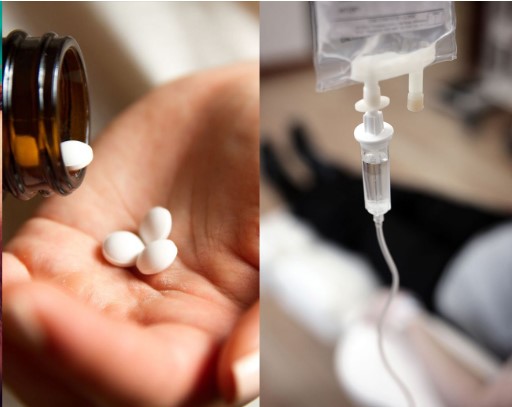Sedation dentistry is increasingly popular among individuals who experience dental anxiety or require extensive dental procedures. When it comes to achieving deeper sedation where patients can fall asleep and wake up with their dental work completed, IV sedation dentistry is considered the superior option, Oral Sedation vs IV Sedation dentistry better? IV sedation is better because it allows for more predictable, rapid, and safe attainment of deeper levels of sedation.
What is dental sedation?
Dental sedation is a method employed in dental procedures to induce relaxation and enhance patient comfort. Various types of dental sedation, such as oral sedation, IV sedation, and anesthesia, can be utilized based on the unique needs of each patient. The selection of the appropriate sedation approach is tailored to the individual patient’s specific requirements and preferences.
Oral Sedation vs. IV Sedation Which sedative is better? Why?
Oral sedation is a viable option; however, it’s important to note that sedative dental drugs administered orally typically have a longer onset of action, which may lead to less predictable levels of sedation once they take effect. In contrast, intravenous dental sedation is often considered a more reliable choice, offering a swifter and more precise control of sedation levels, especially in the event of emergencies when quick reversal is required.

Moreover, it’s worth mentioning that dentists administering IV sedation must hold an additional license dedicated specifically to IV sedation, in addition to their standard dental license. These stringent requirements underscore the significance of anesthesiology and serve as a safeguard to prioritize patient safety during dental procedures.
See More: Implant vs dentures
Basically three types of dental sedations are used.
There are basically three types of sedatives commonly used in dentistry:
What is Oral sedation?
Oral sedation refers to the administration of sedative medication through the mouth. It is commonly available in liquid or pill form, allowing patients to self-administer the sedation.
The purpose of oral sedation is to achieve conscious sedation, where patients experience relaxation and may even doze off during the procedure without being fully asleep. The goal is not to render patients unconscious but rather to alleviate stress and promote enhanced comfort during the experience.
Oral sedatives are an excellent option for individuals who have a fear of needles and prefer an alternative to IV sedation. It is also suitable for patients who feel anxious in the days leading up to the procedure, as the medication can be taken the night before and again an hour prior to the scheduled procedure.
See More: Dental implant grant
What is IV sedation?
IV sedation, also known as intravenous sedation, involves the administration of sedative medication directly into the bloodstream through an IV. This method of sedation acts quickly and induces a state of conscious sedation.
It’s important to differentiate between IV sedation and general anesthesia, as they are not the same. IV sedation refers to any type of sedation delivered via IV, while general anesthesia is a more profound level of sedation that renders the patient completely unconscious.
Whether you opt for oral or IV sedation, it’s crucial to arrange for a trusted friend or family member to drive you to and from your appointment, as the effects of the medication take some time to wear off. For safety purposes, it is also advisable to have an adult accompany you for the remainder of the day following your appointment.
What is general anesthesia?
General anesthesia is a medical technique used to induce a state of unconsciousness in a patient. It is commonly employed for individuals with limited comprehension, significant behavioral challenges, and/or heightened sensitivity to pain.
Different Levels of Dental Conscious Sedation
Your sedation dentist can offer three different levels of dental sedation based on the anticipated level of anxiety and stress.
- Minimal Sedation: At this level, you will remain fully conscious and responsive to verbal communication. Your body functions normally, and you will have complete memory of your treatment procedure in the dental office.
- Moderate Sedation: This level induces a state of drowsiness and sleepiness. You will respond to purposeful verbal commands and touch sensations. Although you may have some memory gaps, you will remember certain parts of your treatment procedure.
- Deep Sedation: At this level, you will respond to repeated verbal commands and painful sensations. While you may not remember the entire treatment procedure, you will retain some recollection of it.
Which type of dental sedation is considered more effective?

When it comes to extensive surgical procedures involving bone cutting and drilling, IV dental sedation is the preferred choice. Oral sedation, on the other hand, is less effective and not considered adequate for major surgeries. Oral sedatives need to be taken at least an hour before the dental procedures, and it is important to have someone accompany you to the dental office as you will be unable to drive independently after taking them.
The choice between oral sedation and IV sedation dentistry depends on the patient’s anxiety levels, the duration of the procedure, and the patient’s perception of the procedure’s level of fear.
See More: Root canal treatment side effects
Is there any difference between the cost of oral sedation and IV sedation?
IV sedation has a higher initial cost compared to oral sedation. However, if we take into account the benefits it offers, it can be seen as cost-effective. One of the main advantages of IV sedation is that it allows multiple dental procedures to be performed in a single visit, which ultimately makes it more cost-efficient.
What is conscious sedation dentistry?
Conscious sedation dentistry involves the use of anesthesia to render a patient unconscious. This is typically suggested for individuals with limited understanding, significant behavioral challenges, and/or a heightened sensitivity to pain.
How do I know which one is right for me?
To identify the most suitable sedation method for your specific requirements, an in-depth consultation with your dentist will take place prior to your appointment. Your individual needs and circumstances will guide the choice of the most appropriate sedation technique.
Sedation Dentistry at Dentist For Life
At Dentist For Life, we understand that visiting the dentist can be a source of anxiety or discomfort for some patients. This is why we are dedicated to providing a wide range of options to ensure your dental experience is as stress-free and comfortable as possible. Sedation dentistry is one such option that we offer, allowing you to receive the essential dental care you need in a relaxed and anxiety-free environment.
Sedation dentistry involves the use of various techniques and medications to help patients relax during dental procedures. Whether you have dental anxiety, a low pain threshold, or require extensive dental work, our skilled and compassionate team is here to provide you with the care you need while ensuring your peace of mind.
In this comprehensive guide to sedation dentistry at Dentist For Life, we will explore the different types of sedation available, their benefits, and how they can make your dental visits more pleasant and stress-free. We are committed to ensuring your oral health and comfort, and sedation dentistry is just one of the ways we achieve this goal.



